
Jeonbuk State, also known as Jeonbuk is a Special Self-governing Province of South Korea in the Honam region in the southwest of the Korean Peninsula. Jeonbuk borders the provinces of South Chungcheong to the north, North Gyeongsang and South Gyeongsang to the east and South Jeolla to the south.

South Jeolla Province, also known as Jeonnam, is a province in the Honam region, South Korea, and the southernmost province in mainland Korea. South Jeolla borders the provinces of North Jeolla to the north, South Gyeongsang to the northeast, and Jeju to the southwest in the Korea Strait.
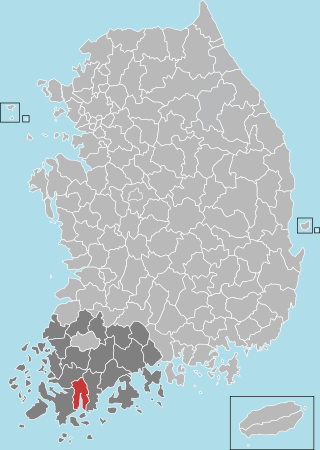
Gangjin County is a county in South Jeolla Province, South Korea. Gangjin county proper was established in 1895. The county office is located in Gangjin-eup.

Hampyeong County (Hampyeong-gun) is a county in South Jeolla Province, South Korea.

Jangheung County is a county in South Jeolla Province, South Korea.

Muan County (Muan-gun) is a county in South Jeolla Province (Jeollanam-do), South Korea. In 2005, Muan County became the capital of Jeollanam-do following the transfer of the provincial office from its previous location, Gwangju to the village of Namak in Muan. Muan International Airport was opened here, and will eventually replace the airports in Gwangju and Mokpo.
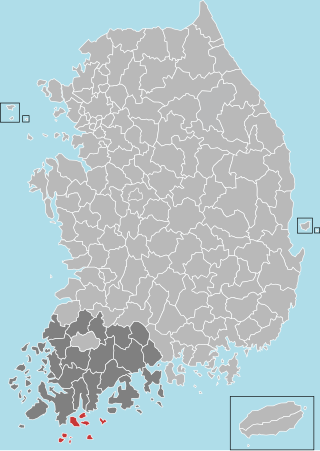
Wando County is a county in South Jeolla Province, South Korea. It takes its name from the island of Wando, which is the largest island within the county and serves as the county seat. Wando island is perhaps most famous for Cheonghaejin, the former headquarters of Jang Bogo, a 9th-century Korean historical figure whose private fleet and army dominated the sea routes in the Yellow Sea. Wando's most famous native in modern times is champion golfer K.J. Choi.

Yeongam is a city and county in South Jeolla Province, South Korea. Bordered with Mokpo and Naju to the north, Jangheung County to the east, and Haenam and Gangjin to the south, Yeongam County comprises two eups and nine myeons, populated with about 57,000 people, and its county hall is seated in Yeongam-eup.
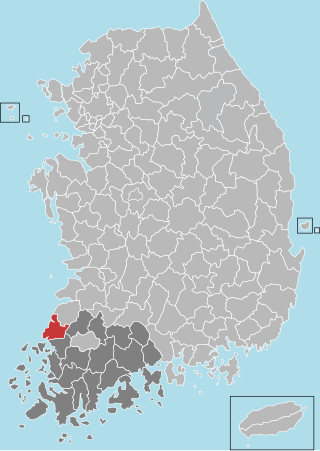
Yeonggwang County (Yeonggwang-gun) is a county in South Jeolla Province, South Korea.

Gimje is a city in North Jeolla Province, South Korea.

Buan County (Buan-gun) is a county in Jeonbuk Sate, South Korea. It is bounded by the city of Jeongeup on the east, the county of Gochang on the south, the city of Gimje on the north, and Yellow Sea on the west. Buan is divided into 1 eup, 12 myeon, and 510 ri. Buan had a 2001 estimated population of 74,716 people and a 2018 population of 54,441 people with an area of 493.35 km2. Famous people from Buan include Joseon Dynasty kisaeng and poet, Yi Mae-chang. Like many rural areas in southern Korea, it has seen shrinking population with many younger people moving north to larger cities such as Seoul. This county should not be confused with Muan, the new capital of South Jeolla Province.
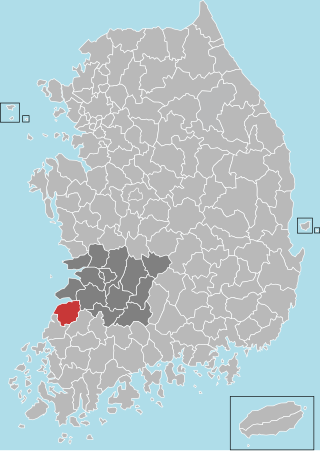
Gochang County is a county in North Jeolla Province, South Korea. It is a rural area, and is home to only one institution of higher education: Gochang Polytechnic College.

Boryeong, commonly known as Daecheon, is a city in South Chungcheong Province, South Korea. It is located on the coast of the Yellow Sea. It lies on the Janghang Line railroad, which connects it to Seoul via the Gyeongbu Line. It is also connected to the Seohaean Expressway. Boryeong is known around Korea for its beaches, particularly Daecheon Beach, and its annual mud festival around July, Boryeong Mud Festival. The city's beach-mud is widely touted for its cosmetic properties. As elsewhere along the southwest coast of the Korean peninsula, there are numerous small islands, many of which are connected by ferry to Daecheon Port.

Cheongyang County is a county in South Chungcheong Province, South Korea. A predominantly rural area, it is known throughout Korea for the spicy Cheongyang chili peppers which are grown there. Another noted local specialty is the fruit of the gugija. The county is home to Cheongyang Provincial College.

Dangjin is a city in South Chungcheong Province, South Korea. It stands on the south shore of the Bay of Asan. Dangjin borders Incheon, Pyeongtaek, and Hwaseong by sea, and Seosan, Yesan, and Asan by land. Its name means "Tang ferry," and refers to the historic role of Dangjin's harbor in connecting Korea to the other side of the Yellow Sea. This role continues to be important in the city's economy, which relies on a mixture of agriculture and heavy industry. The city has the same Hanja name (唐津市) as Karatsu in Saga Prefecture, Japan.

Geumsan County is a county in South Chungcheong Province, South Korea. It borders Muju County, North Jeolla Province (Jeollabuk-do), which is famous for its ski resort nearby.

Seogwipo is the second-largest city on Jeju Island, settled on a rocky volcanic coastline in the southern part of Jeju Province, South Korea. In July 2006, Seogwipo's boundaries were expanded to include the entire southern half of Jeju island. A UNESCO World Heritage Site and 2002 FIFA World Cup host, it had a population of 155,691 as of December 31, 2011.

National Treasure (Korean: 국보) is a national-level designation within the heritage preservation system of South Korea for tangible objects of significant artistic, cultural and historical value. Examples of objects include art, artifacts, sites, or buildings. It is administered by the Cultural Heritage Administration (CHA). Additions to the list are decided by the Cultural Heritage Committee.
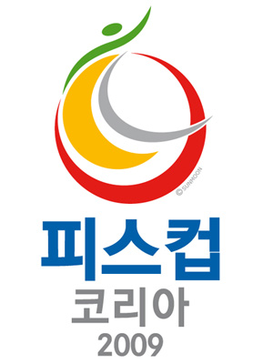
The 2009 Korean League Cup, also known as the Peace Cup Korea 2009, was the 22nd competition of the Korean League Cup. It began on 25 March 2009, and ended on 16 September 2009.

The Great Merchant is a 2010 South Korean historical drama starring Lee Mi-yeon, Han Jae-suk, Park Sol-mi, Ha Seok-jin, and Go Doo-shim. It aired on KBS1 from March 6 to June 13, 2010 on Saturdays and Sundays at 20:40 for 30 episodes.






























